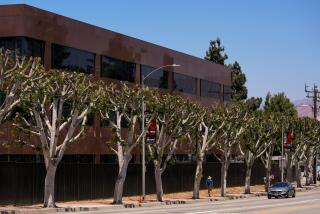Some simple rules to prune by
- Share via
Despite what you’ve heard, one of the worst things you can do to a tree is prune it. Radical concept? Hardly.
“Trees in their natural habitats do not need pruning to thrive and do quite well without it,” says Jan C. Scow, a registered consulting arborist. “Before you prune, always ask yourself ‘Why?’ ”
Repeated or heavy pruning is rarely necessary and often harmful to trees. Improper pruning lowers a tree’s value, shortens its lifespan and leads to higher maintenance costs.
Major thinning, a practice called “lacing out,” makes for pretty silhouettes and temporary size reduction. But it also weakens trees by disrupting their ability to feed themselves (less foliage means reduced photosynthesis) and inducing unnatural growth surges.
And topping of tall trees is discouraged. “Topping makes trees more dangerous, not safer,” Scow says, “because they produce poorly attached, vigorously growing limbs, high up in the air.” The solution: Plant the right tree for the place.
Pruning less, if at all, is always better. “It’s generally best to remove no more than 10% to 25% of the live foliage at any one time,” Scow says. “And older trees are less tolerant of lost greenery and should be treated accordingly.”
In mild-winter climates, light pruning can be performed any time. But, when heavier pruning is required, it’s wise to wait until pests are less active.
Pines and eucalyptus are vulnerable to boring beetles and should be pruned during the cool months, when these destructive insects are least likely to attack.
Most experts agree that coast live oak and other native oaks should be pruned in late summer, during their dry-season dormancy. Winter cuts stimulate growth, inviting a fungus called witches’ broom that thrives on tender new tissue.
However, Bart O’Brien, director of horticulture at Rancho Santa Ana Botanic Garden in Claremont, recommends December pruning for toyon (Heteromeles arbutifolia), an evergreen native also known as California holly. “Berry-laden boughs can be brought indoors for holiday decoration. Summer pruning removes flowers, resulting in fewer berries later in the year.”
O’Brien advises that California native trees that lose their leaves in winter -- such as alder, willow and sycamore -- be trimmed when leafless. An exception: spring-flowering western redbud (Cercis occidentalis); prune it after the blossoms fade.
It’s easier to prune all deciduous trees, including fruit trees, after leaf drop, when their frameworks are exposed. (Do your research: Fruit-tree pruning is complicated. Each type must be treated differently, and removing the wrong wood will diminish your harvest.)
Certain guidelines are universal. Prune young trees for good structure. It’s better to remove a branch when it is small than when it is large. As needed, remove crossing inner growth and dead, diseased, decaying or unsound branches.
“Any tree that presents a risk of failure needs to be pruned to reduce that risk -- if there’s a target,” Scow says. “Safety must always be addressed. Less is always important, but risk reduction is one of the only reasons that pruning is always justified. It may be necessary to reduce the weight of a limb so it doesn’t break, and badly diseased branches must be removed before they fall.”
For tree health and your own safety, don’t skimp. Invest in well-made tools, including bypass pruners, loppers, a handsaw and a pole pruner. Keep them clean and sharp.
When pruning, always protect what’s left behind. The kindest cuts prevent bark damage and infection by allowing tissues to callus over and heal naturally.
If using a pole pruner, be aware of wires before you start cutting. Never use metal poles and don’t work around high voltage unless trained.
Some pruning tasks are too difficult for amateurs.
“Homeowners should not be using chainsaws unless they’re extremely competent,” Scow says. “In general, nonprofessionals shouldn’t get off the ground or up into a tree or on a high ladder.”
A note of caution: Always check before either you or a pro make any cuts. Many communities have ordinances that affect your ability to prune trees -- especially oaks.
And one last advisory. As we move into spring, check the boughs for nesting birds and adjust your pruning schedule appropriately.






